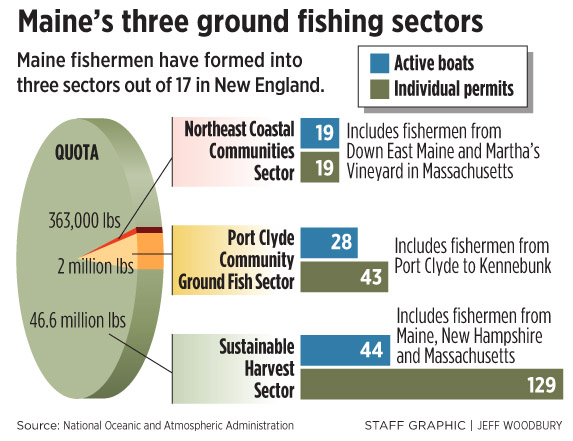New regulations are about to fundamentally change the groundfishing industry in Maine and other New England states.
Overnight many New England fishermen, known for their fierce independence in an industry famous for its gold-rush mentality, will be fishing cooperatively in groups, sharing the catch assigned to them by regulators. They will depend on each other to obey strict new limits lowering the amount of fish that may be caught for many species.
“They all kind of work together,” said Glen Libby, a fisherman and chairman of the Midcoast Fishermen’s Association in Port Clyde.
The new rules, which take effect with the new fishing year May 1, are aimed at rebuilding the stocks of the region’s legendary cod and 16 other bottom-dwelling fish species.
The rules follow years of effort by the federal government and conservation groups to stop overfishing. While some stocks, such as cod and haddock, have begun to rebound, most of the other species have not, federal regulators say.
The rules encourage boat owners to form business groups, called sectors, which will be assigned a share of the annual catch quota for each species. The system is designed to provide the industry with more flexibility in determining when and how to fish.
But there is a lot of concern among fishermen about how it will all work. Fishermen are also skeptical of the federal government’s conclusions about fish stocks, such as pollock, which they say are undercounted.
“I don’t know if it will be better or worse,” Libby said.
And there is no doubt that Maine will lose more of its own dwindling fleet, down to 65 boats from 350 a few decades ago.
“We expect there to be fallout. There are just not enough fish for the current fleet,” said Terry Stockwell, deputy commissioner of the Maine Department of Marine Resources.
Many Maine groundfishermen are already struggling to make a living. A single boat owner with one helper is doing really well if he clears $30,000 to $40,000 a year to live on from a gross income of $150,000 to $200,000, say those in the industry.
“Most guys are a blown engine or a major catastrophe away from going out of business,” said Jim Frank, a retired Washington fisherman who is helping to run one of Maine’s fishing sectors.
Fishermen in sectors will no longer be governed by how many days they can fish, and they will have fewer restrictions on where they fish, compared to those who have chosen not to join a sector.
Fifty-five percent of the region’s 1,480 fishing boats have joined one of 17 sectors that have been approved by regulators in New England. Historically, these fishermen have accounted for 98 percent of the fish landings.
Each sector is allotted fish according to the members’ landings between 1996 and 2006. Each member is assigned a share of the catch based on their individual history. Members may trade their shares within the sector. The sectors may also trade their allocation with another sector.
Other fishermen have chosen to fish in what is called the “common pool” under the old rules and the new species quotas.
Maine fishermen have formed three sectors, including the Northeast Coastal Communities sector, which includes fishermen from Down East and Martha’s Vineyard in Massachusetts; the Port Clyde Community Groundfish Sector, with fishermen from Port Clyde to Kennebunk; and the Sustainable Harvest Sector, the largest in New England, with fishermen from Maine, New Hampshire and Massachusetts.
The sectors are loosely grouped by geographic area, but they may all fish in the same areas. They will function like a private business, and many closely guard their business information, citing proprietary concerns.
Some of the sectors charge membership fees. They have hired managers — with money from the National Oceanic and Atmospheric Administration — to help them decipher the complex groundfishing regulations and, as a group, keep track of how many fish have been landed and how many have been thrown back.
“It is phenomenally complex,” said Hank Soule, former general manager of the Portland Fish Exchange and now manager of the Sustainable Harvest Sector.
Membership varies in each sector, from four to 50 boats. Some sectors are careful about who they let in because the whole sector is liable if one member breaks the rules, said Soule.
Fishermen in sectors are not expected to rush out and start fishing May 1, unlike fishermen in the common pool, who will probably fish as much as they can before the quota for the pool is filled.
“They are going to take a wait-and-see attitude, see what the fish prices do,” said Soule.
There will be some help available for small-scale Maine fishermen in the months ahead.
The state is setting up a permit bank with $3 million in federal money that will lease out permits for fishing days or catch shares. The money is expected to be targeted for boats 45 feet and under. The permits will become available sometime later this year.
Staff Writer Beth Quimby can be contacted at 791-6363 or at:
bquimby@pressherald.com
Send questions/comments to the editors.



